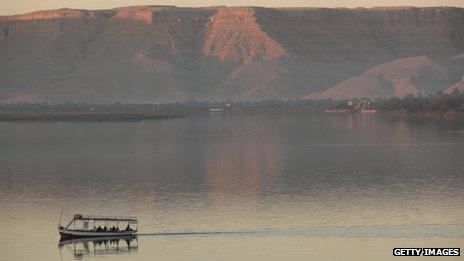Ethiopia diverts Blue Nile for controversial dam build
- Published

Egypt and Sudan are concerned that the dam will affect vital water supplies
Ethiopia has started diverting a stretch of the Blue Nile to make way for a $4.7bn (£3.1bn) hydroelectric dam that has caused a dispute with countries downstream, state media say.
The Great Ethiopian Renaissance Dam, which is currently under construction, is part of a $12bn (£8bn) investment project to boost power exports.
The Blue Nile is one of two major tributaries of the Nile - one of the world's longest rivers.
Egypt and Sudan object to the dam.
They say it violates a colonial-era agreement, which gives them rights to 90% of the Nile's water.
'Fair use'
The Grand Renaissance Dam, which is being built in the Benishangul-Gumuz region bordering Sudan, will eventually have a 6,000 megawatt capacity, according to the Ethiopian government. This is the equivalent of at least six nuclear power plants.
"The dam is being built in the middle of the river so you can't carry out construction work while the river flowed," Mihret Debebe, chief executive officer of the state-run Ethiopian Electric Power Corporation, told the Reuters news agency.
"This now enables us to carry out civil engineering work without difficulties. The aim is to divert the river by a few metres and then allow it to flow on its natural course."
Ethiopia claims to be the source of about 85% of the total water in the Nile.
The Blue Nile originates in the country's Lake Tana and flows hundreds of miles north into Sudan and then Egypt before eventually flowing into the Mediterranean.
Egypt is particularly dependant on the water supply, with growing populations placing it under increasing strain, although Sudan also relies on the source.
Egypt's Deputy Foreign Minister for African Affairs, Ali Hifni, said that the diversion of the river was not something to worry about, according to the Egyptian state-run news agency Mena.
But Mr Hifni said that the dam itself was of concern.
Experts from Ethiopia, Egypt and Sudan are set to announce findings of a study into the impact of the Ethiopian dam on the Nile's flow in the coming weeks.
Ethiopia's energy minister, moved to dispel fears over the dam's impact, Reuters reports.
"The dam's construction benefits riparian countries, showcases fair and equitable use of the river's flow and does not cause any harm on any country," Alemayehu Tegenu said.
- Published12 October 2020
- Published7 January 2019